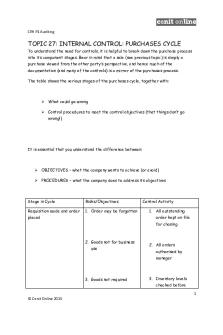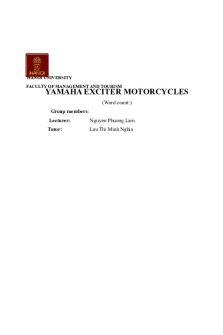Topic 2.7 Overview of Employee Selection-modified PDF

| Title | Topic 2.7 Overview of Employee Selection-modified |
|---|---|
| Author | Jocelyn Jones |
| Course | Workforce Planning |
| Institution | Western Governors University |
| Pages | 2 |
| File Size | 80.7 KB |
| File Type | |
| Total Downloads | 51 |
| Total Views | 134 |
Summary
summary...
Description
Workforce Planning, My Educator for Western Governors University
2.7 Recruiting Metrics As discussed earlier, effective organizations will use metrics to provide insight into both their internal and external recruiting efforts. Recruitment metrics can help HR professions better track and understand where candidates come from, the time it takes to hire new employees, the financial resources required to hire additional employees, retention rates, acceptance ratios, and gender and diversity rates. Three important recruiting metrics that every HR professional should use include the yield ratio, quality hire measurements and cost per hire Recruitment Yield Ratio The recruitment yield ratio helps HR professionals understand if their recruitment strategy is reaching the right applicants and if the organization is recruiting from the most effective sources. Yield ratio can be calculated at various stages in the recruitment process. For example, an HR Manager can use the recruitment yield ratio to determine if money spent advertising in a trade journal was money well spent or wasted. For this example, the recruitment yield ratio is determined by doing the following: 1. Identify the number of applicants from each source. 2. Identify the number of applicants from each source that made it through the 2nd round of recruitment. 3. Take the total number of applicants who made it to the 2nd round of recruitment and divide that number by the number of applicants from a particularly source. For example, let’s image that a company advertised a new position to four separate groups, including: 1. The Company Website (20 applicants, 4 made it to 2nd round of recruitment) 2. A Trade Journal (5 applicants, 2 made it to 2nd round of recruitment) 3. A Local Newspaper (15 applicants, 1 made it to 2nd round of recruitment), and 4. A Local University’s Recruitment Office (10 applicants, 1 made it to 2nd round of recruitment)
Workforce Planning, My Educator for Western Governors University
The HR manager for the organization could determine the recruitment yield ratio by taking the number of applicants who made it to the 2nd round of recruitment and dividing that number by the number of applicants from each source: Company Website: 4/20*100 = 20% Trade Journal: 2/5*100 = 40% Local Newspaper: 1/15*100 = 6.7% Local University: 1/10*100 = 10% From this analysis, we can easily determine that while the trade journal attracts less applicants, the applicants it does attract are much more qualified for the job – important information for any HR professional. Likewise, yield ratios can be used to predict how many applications a company will need in order to meet a recruitment objective. For example, if the HR Manager wanted 10 viable candidates for the new position, the HR Manager could use the yield ratio divided by the goal to determine the number of required applications. Let's look at the example above. Given that the trade journal produced the highest yield ratio (40%) the HR Manager is going to use this source to determine how many applications are needed. Goal = 10 Viable Candidates Yield Ratio = 40% or .40 10/.40 = 25 applications
If the HR Manager decides to use the top two sources, a new yield ratio would need to be created by first adding together the number of applications from each source and then dividing this number by the total number of applicants from the two sources that made it to the next round. Number people who applied: 25 (20 website, 5 trade journal) Number of people who made it to 2nd round = 6 (4 website, 2 trade journal) 6/25*100 = 24% Once the new yield ratio has been calculated, the HR Manager can use this information to determine the number of applications needed from the two sources. Following the procedure we used above: Goal = 10 Viable Candidates Yield Ratio = 24% or .24 10/.24 = 42 applications...
Similar Free PDFs

Math g6 m1 topic a overview
- 2 Pages

1.2 Overview of Anthropology
- 2 Pages

Employee wellbeing report of tcs
- 9 Pages

An Overview of Nutrition
- 13 Pages

Overview of molybdenum chemistry
- 18 Pages

Overview
- 4 Pages

Overview of key C168 concepts
- 4 Pages

Chapter 1 Overview of Govt
- 4 Pages

Overview of the immune system
- 3 Pages
Popular Institutions
- Tinajero National High School - Annex
- Politeknik Caltex Riau
- Yokohama City University
- SGT University
- University of Al-Qadisiyah
- Divine Word College of Vigan
- Techniek College Rotterdam
- Universidade de Santiago
- Universiti Teknologi MARA Cawangan Johor Kampus Pasir Gudang
- Poltekkes Kemenkes Yogyakarta
- Baguio City National High School
- Colegio san marcos
- preparatoria uno
- Centro de Bachillerato Tecnológico Industrial y de Servicios No. 107
- Dalian Maritime University
- Quang Trung Secondary School
- Colegio Tecnológico en Informática
- Corporación Regional de Educación Superior
- Grupo CEDVA
- Dar Al Uloom University
- Centro de Estudios Preuniversitarios de la Universidad Nacional de Ingeniería
- 上智大学
- Aakash International School, Nuna Majara
- San Felipe Neri Catholic School
- Kang Chiao International School - New Taipei City
- Misamis Occidental National High School
- Institución Educativa Escuela Normal Juan Ladrilleros
- Kolehiyo ng Pantukan
- Batanes State College
- Instituto Continental
- Sekolah Menengah Kejuruan Kesehatan Kaltara (Tarakan)
- Colegio de La Inmaculada Concepcion - Cebu






